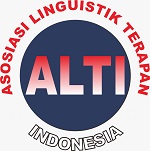The Effect of Using Blended Learning Model on Enhancing Students' Speaking Skills in Senior High Schools
DOI:
https://doi.org/10.33394/jollt.v9i1.2921Keywords:
Blended learning, Speaking skill, Google classroom,Abstract
References
Abe, E. (2013). Communicative language teaching in Japan: Current practices and future prospects. English Today, 29(2), 46–53. https://doi.org/10.1017/S0266078413000163
Anas, I. (2019). Behind the scene: Student-created video as a meaning-making process to promote student active learning. Teaching English with Technology, 19(4), 37–56.
Aprianoto, & Haerazi (2019). Development and assessment of an interculture-based instrument model in the teaching of speaking skills. Universal Journal of Educational Research 7(12) pp. 2796-2805. DOI: https://doi.org/10.13189/ujer.2019.071230
Ardiansyah, A. (2020). Improving students’ speaking skills through the use of video-based scientific approach. Journal of Languages and Language Teaching, 8(3), 222-236. doi: https://doi.org/10.33394/jollt.v8i3.2734
Arikunto, S., & Supardi. (2012). Penelitian Tindakan Kelas . Jakarta : Bumi Aksara
Brown, H. D., & Abeywickrama, P. (2004). Language assessment. Principles and Classroom Practices. White Plains, NY: Pearson Education
Carman, J. M. (2005). Blended Learning Design : Five Key Ingredients. Blended Learning Design: 5 Key Ingredients. https://doi.org/10.1109/CSSE.2008.198
Ginaya. G, Rezeki. M., Astuti, S. (2018). The Effects of Blended Learning to Students' Speaking Ability: A Study of Utilizing Technology to Strengthen the Conventional Instruction. IJLLC (International Journal of Linguistics, Literature and Culture),4(3), 1-14. http://dx.doi.org/10.21744/ijllc.v0i0.000
Garrison, D. R. (2011). E-learning in the 21st century: A framework for research and practice. Taylor & Francis.
Haerazi, H., May Vikasari, R., & Prayati, Z. (2019). The use of scientific-based approach in ELT class to improve students’ achievement and classroom interaction. Register Journal, 12(2), 157-180. https://doi.org/10.18326/rgt.v12i2.157-180
Hengki, T,P (2014). Implementasi Model Pembelajaran Blended Learning Untuk Meningkatkan Aktifitas Belajar Multimedia Siswa Kelas XI Multimedia 1 SMK Muhammadiah 2 Klaten Utara Tahun Ajaran 2013/2014. Yogyakarta (ID):UNY
Hoesny, M., Cahyani, H., & Aziz, I. (2020). The use of edmodo in ESP classroom: A study on students’ perception and classroom activities. Journal of Languages and Language Teaching, 8(3), 237-250. doi: https://doi.org/10.33394/jollt.v8i3.2602
Limbong, E. (2017). Designing and Developing Supplemental Technology of PACI Model Materials through Blended Learning Methods. In Celt: A Journal of Culture, English Language Teaching & Literature (Vol. 16, Issue 2). https://doi.org/10.24167/celt.v16i2.771
Pramila, K & Thomas, J (2019). Impact of Blended Learning on the Speaking Skills of English as a Foreign Language (EFL) Learners at Sohar University. Anthropologist, 35(1-3), 47-56. http://DOI: 10.31901/24566802.2019/35.1-3.2039
Maryam, S. (2020). Utilizing communicative language games to improve students’ speaking ability. Journal of Languages and Language Teaching, 8(3), 251-263. doi: https://doi.org/10.33394/jollt.v8i3.2733
Qariah, M., Munoto., & Lilik, A. (2017). Pengaruh Model Pembelajaran Blended Learning Dan Motivasi Belajar Terhadap Hasil Belajar Siswa. Jurnal Penelitian Ilmu Pendidikan. 2(10),97-110
Sarah, B (2015). Efektivitas Model Blended Learning Terhadap Motivasi Dan Tingkat Pemahaman Mahasiswa Mata Kuliah Algoritma Dan Pemrograman. Jurnal Pendidikan Vocasi.1(5),74-87
Serdar Tülüce, H., & Çeçen, S. (2018). The use of video in microteaching: affordances and constraints. ELT Journal, 72(1), 73–82. https://doi.org/10.1093/elt/ccx028
Sharma, P. (2010). Blended learning. ELT Journal, 64(4), 456–458. https://doi.org/10.1093/elt/ccq043
Sofiana, N (2015). Implementasi Blended Learning Pada Mata Kuliah Extensive Listening. Jurnal Tarbawi .1(12), 59-70.
Sukmawati, S., & Nensia, N. (2019). The Role of Google Classroom in ELT. International Journal for Educational and Vocational Studies, 1(2), 142–145. https://doi.org/10.29103/ijevs.v1i2.1526
Sumarsono, D., Muliani, M., & Bagis, A. (2020). The forecasting power of task-based language teaching and self-efficacy on students' speaking performance. Journal of Languages and Language Teaching, 8(4), 412-421. doi: https://doi.org/10.33394/jollt.v8i4.2848
Suryaningsih. 2017. Pengaruh Metode Pembelajaran Show and Tell Terhadap Keterampilan Berbicara Siswa Kelas IV Tema 6 Daerah Tempat TinggalKu Di SD Muhammadiah Condongcatur .Yogyakarta (ID): UIN Sunankalijaga Yogyakarta.
Tomlinson, B. (2019). Blended Learning: The Future of ELT ? . The TESOL Encyclopedia of English Language Teaching, 1–7. https://doi.org/10.1002/9781118784235.eelt0941.pub2
Zilka, G. C., Rahimi, I. D., & Cohen, R. (2019). Sense of Challenge, Threat, Self-Efficacy, and Motivation of Students Learning in Virtual and Blended Courses. American Journal of Distance Education, 33(1), 2–15. https://doi.org/10.1080/08923647.2019.1554990
Wahyuni. S, Elfita F. (2018). Pengaruh Blended Learning Model dan Sikap Berbahasa Terhadap Kemampuan Menulis Bahasa Inggris Siswa Sekolah Menengah Negeri di Pekan Baru. Jurnal GERAM.1(6),1-9
Downloads
Published
How to Cite
Issue
Section
Citation Check
License
License and Publishing Agreement
In submitting the manuscript to the journal, the authors certify that:
- They are authorized by their co-authors to enter into these arrangements.
- The work described has not been formally published before, except in the form of an abstract or as part of a published lecture, review, thesis, or overlay journal.
- That it is not under consideration for publication elsewhere,
- That its publication has been approved by all the author(s) and by the responsible authorities – tacitly or explicitly – of the institutes where the work has been carried out.
- They secure the right to reproduce any material that has already been published or copyrighted elsewhere.
- They agree to the following license and publishing agreement.
Copyright
Authors who publish with JOLLT Journal of Languages and Language Teaching agree to the following terms:
- Authors retain copyright and grant the journal right of first publication with the work simultaneously licensed under a Creative Commons Attribution License (CC BY-SA 4.0) that allows others to share the work with an acknowledgment of the work's authorship and initial publication in this journal.Â
- Authors are able to enter into separate, additional contractual arrangements for the non-exclusive distribution of the journal's published version of the work (e.g., post it to an institutional repository or publish it in a book), with an acknowledgment of its initial publication in this journal.
- Authors are permitted and encouraged to post their work online (e.g., in institutional repositories or on their website) prior to and during the submission process, as it can lead to productive exchanges, as well as earlier and greater citation of published work.
Licensing for Data Publication
- Open Data Commons Attribution License, http://www.opendatacommons.org/licenses/by/1.0/ (default)
This work is licensed under a Creative Commons Attribution-ShareAlike 4.0 International License.
















